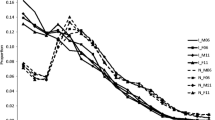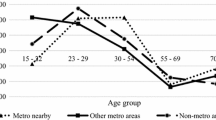Summary
Aboriginal migration to the cities is frequently assumed to be adding to the population of urban Aborigines. An analysis of actual patterns of Aboriginal migration to the large Australian cities (major urban areas), using data from the 1981 and 1986 Australian Censuses, shows that the major urban areas of New South Wales and Victoria were actually losing Aboriginal population through net migration throughout the period 1976 to 1986. At both inter-State level and country-to-city lev/el, any Aboriginal migration flow in one direction tends to be almost cancelled out by a flow of similar size in the opposite direction. However, there are definite age-specific patterns. In particular, there is movement of young single adults to the cities, often counterbalanced by migration of somewhat older adults with their children to the country. Aboriginal migrants have higher levels of labour-force participation than equivalent categories of non-migrants.
Similar content being viewed by others
References
AUSTRALIA (1973), Commonwealth Bureau of Census and Statistics,Bulletin 9: the Aboriginal Population, Commonwealth Bureau of Census and Statistics, Canberra.
BROOM, L. and JONES, F.L. (1973),A Blanket a Year, Australian National University Press, Canberra.
BROWN, J.W., HIRSCHFIELD, R. and SMITH, D. (1974),Aboriginals and Islanders in Brisbane, Australian Government Publishing Service, Canberra.
Gale, F. (1972),Urban Aborigines, Australian National University Press, Canberra.
Gray, A. (1985), “Some myths in the demography of Aboriginal Australians”,Journal of the Australian Population Association, 2, 2: 136–49.
SCOTT, W.D. and COMPANY (1973),Housing Needs in the Australian Aboriginal and Torres Strait Islander Population, Report to the Commonwealth Department of Aboriginal Affairs, Canberra.
SMITH, L.R. (1980a),The Aboriginal Population of Australia, Australian National University Press, Canberra.
SMITH, L.R. (1980b), “New black town or black new town: the urbanization of Aborigines”, in I.H. BURNLEY, R.J. PRYOR and D.T. ROWLAND (eds),Mobility and Community Change in Australia, University of Queensland Press, St. Lucia.
YOUNG, E.A. (1981), “The medium-sized town in the context of mobility: rural-urban linkages and decentralization-policies”, in G.W. JONES and H.V. RICHTER (eds),Population Mobility and Development, Development Studies Centre, Australian National University, Canberra.
YOUNG, E.A. (1982),Town Populations, Australian National University Press, Canberra.
Author information
Authors and Affiliations
Rights and permissions
About this article
Cite this article
Gray, A. Aboriginal migration to the cities. Journal of Population Research 6, 122–144 (1989). https://doi.org/10.1007/BF03029350
Issue Date:
DOI: https://doi.org/10.1007/BF03029350




